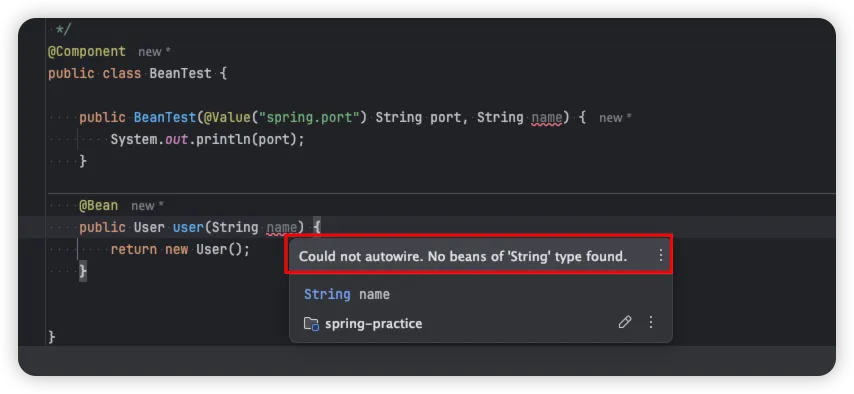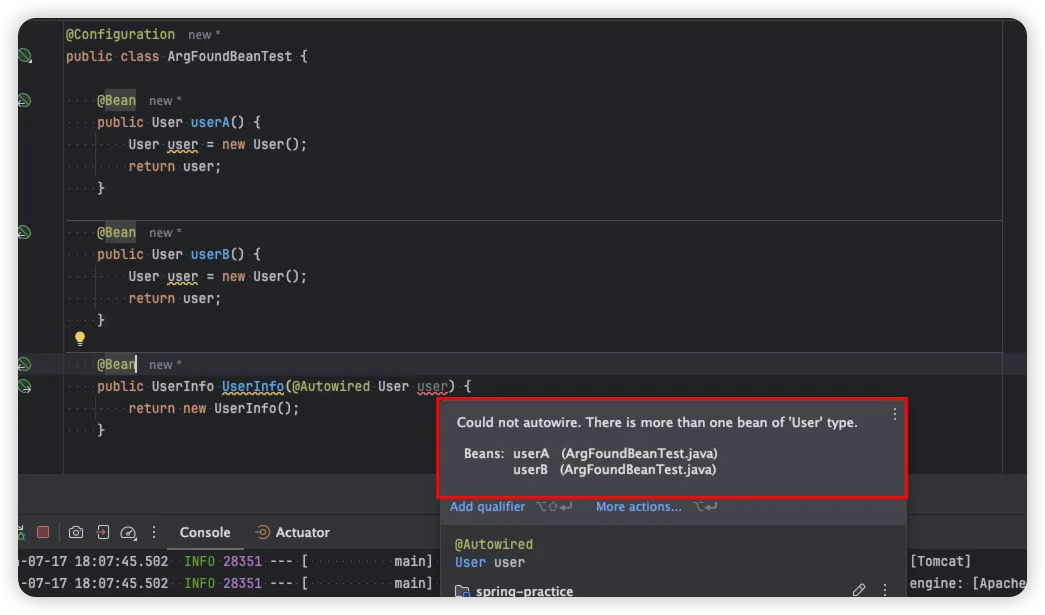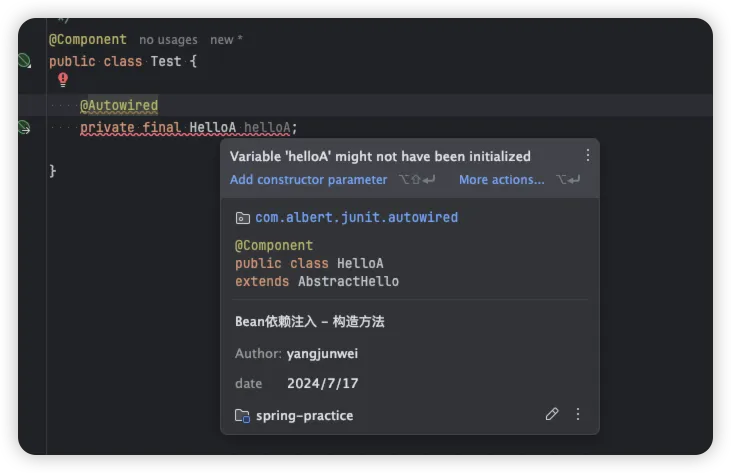IOC
其中构造方法注入和工厂方法注入是强依赖,因为Bean创建和属性注入放到一起了。
比如构造方法注入,创建对象的同时进行属性注入,这种属于强依赖。
而强依赖是解决不了循环依赖的问题的,因为创建对象和属性注入属于一体不可分的。
我们解决循环依赖是先创建对象,然后属性注入的时候利用三级缓存解决的。
public BeanTest(@Value("spring.port") String port, String name) {
System.out.println(port);
}IOC容器有两类,BeanFactory 和 ApplicationContext。
- BeanFactory 延迟创建 Bean。
- ApplicationContext 启动时初始化所有 Bean。
Summer Framework也仅实现Annotation配置+@ComponentScan扫描方式完成容器的配置。
扫描类 - ResourceResolver
- 扫描指定文件夹下的所有类
- 扫描指定jar包下的所有类
配置项注入 - PropertyResolver
- 加载配置文件 application.properties 里面的配置项到内存中。
- 扫描@Value注解
注解类似标识,给类或者方法增加注解标识,后续通过扫描注解可以实现注解具体的功能。
扫描Bean
- 扫描指定包下所有的类
- 扫描@Component下所有的类
- 扫描@Import导入的类
- 加载需要放入容器的Bean
- 扫描加了@Component注解的类
- 扫描加了@Configuration的类
同时扫描配置类里面加了@Bean注解的方法,作为Bean注入。
java//扫描Configuration注解 Configuration configuration = ClassUtils.findAnnotation(clazz, Configuration.class); if (configuration != null) { //扫描Configuration注解里面的@Bean scanFactoryMethods(beanName, clazz, defs); } var def = new BeanDefinition(ClassUtils.getBeanName(method), beanClass, factoryBeanName, method, getOrder(method), method.isAnnotationPresent(Primary.class), // init method: bean.initMethod().isEmpty() ? null : bean.initMethod(), // destroy method: bean.destroyMethod().isEmpty() ? null : bean.destroyMethod(), // @PostConstruct / @PreDestroy method: null, null);
@Bean注入
可以指定该Bean 注入,同时指定 initMethod 和 destroyMethod 方法。
注入的Bean可以是普通 Java 类。
@Configuration
public class AppConfig {
/**
* @Configuration扫描注入Bean的同时,会扫描该类的所有方法
* 将加了@Bean注解的方法也注入进来
* methodName作为BeanName,返回值作为BeanClass
* @param helloService
* @return
*/
@Bean(initMethod = "init",destroyMethod = "destory")
public HelloB hello(@Autowired HelloService helloService) {
return new HelloB(helloService);
}
}创建 BeanDefinition
BeanDefinition
public class BeanDefinition {
//全局唯一 beanName
String name;
//Bean声明类型
//声明类型和实际类型有区别
Class<?> beanClass;
//Bean实例对象
Object instance = null;
//构造方法
Constructor<?> constructor = null;
//工厂方法名称
String factoryName = null;
//工厂方法
String factoryMethod = null;
//Bean顺序
int order;
//是否标识@Primary
//类型相同的Bean,配置了该注解的优先使用
boolean primary;
String initMethodName;
String destroyMethodName;
//init/destroy方法
//对应 @PostConstruct和 @PreDestroy 方法
Method initMethod;
Method destroyMethod;
}beanClass是声明类型
比如DataSource是声明类型,但是Bean的实际类型是它的子类 HikariDataSource。
不过BeanDefinition中需要的是声明类型,因为实际类型可以通过 bean.getClass 直接获得:
java@Bean(initMethod="init", destroyMethod="close") DataSource createDataSource() { return new HikariDataSource(...); }Order
相同 Class 类型 Bean 设置执行顺序
javapublic List<BeanDefinition> findBeanDefinitions(Class<?> type) { return this.beans.values().stream() //类型过滤 //isAssignableFrom()方法用于判断当前Class对象所表示的类或接口是否可以被指定的另一个Class对象所表示的类或接口所赋值。 .filter(def -> type.isAssignableFrom(def.getBeanClass())) .sorted().collect(Collectors.toList()); }java@Override public int compareTo(BeanDefinition definition) { //比较order int compare = Integer.compare(this.order, definition.getOrder()); if (compare != 0) { return compare; } //order相同再比较name return this.name.compareTo(definition.getName()); }primary
类型相同的Bean,优先使用加了该注解的Bean。
- 类型相同的Bean只允许指定一个@primary。
- 获取到之后只将标注了@primary的Bean返回。
java@Nullable public BeanDefinition findBeanDefinition(Class<?> type) { //查询某个类型下所有Bean,包含子类、实现类 List<BeanDefinition> beanDefinitions = findBeanDefinitions(type); if (beanDefinitions.isEmpty()) { return null; } //找到唯一一个Bean if (beanDefinitions.size() == 1) { return beanDefinitions.getFirst(); } //more than 1 beans,require @Primary List<BeanDefinition> primaryDefs = beanDefinitions.stream().filter(BeanDefinition::isPrimary).toList(); //@Primary唯一标注的Bean if (primaryDefs.size() == 1) { return primaryDefs.getFirst(); } if (primaryDefs.isEmpty()) { throw new NoUniqueBeanDefinitionException(String.format("Multiple bean with type '%s' found, but no @Primary specified.", type.getName())); } else { throw new NoUniqueBeanDefinitionException(String.format("Multiple bean with type '%s' found, and multiple @Primary specified.", type.getName())); } }
工厂方法和工厂名称
在Spring里面,加了@Configuration注解的类就是一个工厂类。
加了@Bean的方法都是一个工厂方法,对应一个Bean。
也就是说@Configuration的类需要遍历注入多个Bean,在创建普通Bean之前要先把@Configuration对应的工厂类创建出来。
void scanFactoryMethods(String factoryBeanName, Class<?> clazz, Map<String, BeanDefinition> defs) {
for (Method method : clazz.getDeclaredMethods()) {
//扫描方法上的@Bean注解
Bean bean = method.getAnnotation(Bean.class);
if (bean != null) {
int mod = method.getModifiers();
//abstract
if (Modifier.isAbstract(mod)) {
throw new BeanDefinitionException("@Bean method " + clazz.getName() + "." + method.getName() + " must not be abstract.");
}
//final
if (Modifier.isFinal(mod)) {
throw new BeanDefinitionException("@Bean method " + clazz.getName() + "." + method.getName() + " must not be final.");
}
//private
if (Modifier.isPrivate(mod)) {
throw new BeanDefinitionException("@Bean method " + clazz.getName() + "." + method.getName() + " must not be private.");
}
Class<?> beanClass = method.getReturnType();
if (beanClass.isPrimitive()) {
throw new BeanDefinitionException("@Bean method " + clazz.getName() + "." + method.getName() + " must not return primitive type.");
}
if (beanClass == void.class || beanClass == Void.class) {
throw new BeanDefinitionException("@Bean method " + clazz.getName() + "." + method.getName() + " must not return void.");
}
var def = new BeanDefinition(ClassUtils.getBeanName(method), beanClass, factoryBeanName, method, getOrder(method),
method.isAnnotationPresent(Primary.class),
// init method:
bean.initMethod().isEmpty() ? null : bean.initMethod(),
// destroy method:
bean.destroyMethod().isEmpty() ? null : bean.destroyMethod(),
// @PostConstruct / @PreDestroy method:
null, null);
addBeanDefinitions(defs, def);
log.debug("define bean: {}", def);
}
}
}创建逻辑
根据扫描到的 Bean 创建 BeanDefinition。
/**
* 根据扫描的ClassName创建BeanDefinition
*/
Map<String, BeanDefinition> createBeanDefinitions(Set<String> classNameSet) {
Map<String, BeanDefinition> defs = new HashMap<>();
for (String className : classNameSet) {
// 反射获取Class
Class<?> clazz = null;
try {
clazz = Class.forName(className);
} catch (ClassNotFoundException e) {
throw new BeanCreationException(e);
}
//Annotation、enum、interface、record不需要加载
if (clazz.isAnnotation() || clazz.isEnum() || clazz.isInterface() || clazz.isRecord()) {
continue;
}
// 是否标注@Component?
Component component = ClassUtils.findAnnotation(clazz, Component.class);
if (component != null) {
log.info("found component: " + clazz.getName());
int mod = clazz.getModifiers();
if (Modifier.isAbstract(mod)) {
throw new BeanDefinitionException("@Component class " + clazz.getName() + " must not be abstract.");
}
if (Modifier.isPrivate(mod)) {
throw new BeanDefinitionException("@Component class " + clazz.getName() + " must not be private.");
}
String beanName = ClassUtils.getBeanName(clazz);
var def = new BeanDefinition(beanName, clazz, getSuitableConstructor(clazz), getOrder(clazz), clazz.isAnnotationPresent(Primary.class),
// named init / destroy method:
null, null,
// 扫描@PostConstruct注解
ClassUtils.findAnnotationMethod(clazz, PostConstruct.class),
// 扫描@PreDestroy注解
ClassUtils.findAnnotationMethod(clazz, PreDestroy.class));
addBeanDefinitions(defs, def);
log.debug("define bean: {}", def);
//扫描Configuration注解
Configuration configuration = ClassUtils.findAnnotation(clazz, Configuration.class);
if (configuration != null) {
//扫描Configuration注解里面的@Bean
scanFactoryMethods(beanName, clazz, defs);
}
}
}
return defs;
}创建Bean
Spring依赖注入
依赖注入四种方法
构造方法注入
javapublic HelloA(@Autowired HelloService helloService) { this.helloService = helloService; }工厂方法注入
java@Bean(initMethod = "init", destroyMethod = "destory") public HelloB helloB(@Autowired HelloService helloService) { return new HelloB(helloService); }set方法注入
java@Autowired public HelloC setHelloService(HelloService helloService) { this.helloService = helloService; return this; }字段注入
java@Autowired HelloService helloService;
循环依赖的问题
其中构造方法注入和工厂方法注入是强依赖,因为Bean创建和属性注入放到一起了。
比如构造方法注入,创建对象的同时进行属性注入,这种属于强依赖。
而强依赖是解决不了循环依赖的问题的,因为创建对象和属性注入属于一体不可分的。
我们解决循环依赖是先创建对象,然后属性注入的时候利用三级缓存解决的。
带入参的构造方法/工厂方法
构造方法所有参数都需要被Spring管理,不然Spring无法创建Bean实例,因为不知道给入参填充具体什么值。
比如入参包含普通类型字段。

入参类型
在Spring中,构造方法和工厂方法注入Bean的时候,入参能使用的注解只包含@Autowired和@Value。
@Autowired用于依赖注入,即注入其他由Spring管理的bean。@Autowired 注解是按照类型注入,需要保证容器中只有一个该类型的Bean 或者 就要加
@Primary注解标识优先使用哪个Bean。
@Value用于设置基本类型或字符串类型的值,这些值通常来自配置文件或其他非bean资源。javapublic BeanTest(@Value("${server.port}") String port) { System.out.println("spring.port =>" + port); }
创建Bean的过程
对于IOC容器来说,创建Bean过程分为两步。
创建Bean实例,注入强依赖。
如果遇到循环依赖直接报错,因为解决不了。
属性注入
对Bean实例进行属性注入,包括 set 方法注入 和 字段注入。
强依赖检测
//首先进行循环依赖检测
if (!this.createingBeanNames.add(def.getName())) {
//重复创建Bean导致的循环依赖
//强依赖抛出异常
//比如创建某个Bean的时候,先把Bean添加到set中。然后执行构造方法,触发循环依赖,发现set已经包含了该Bean
//A->B, B->A
throw new UnsatisfiedDependencyException();
}创建Bean的方式
先进行第一步,创建Bean实例,注入强依赖。
构造方法创建对象
工厂方法创建对象
@Configuration类里面标注了@Bean注解的方法,都是工厂方法对应的Bean对象。
校验 @Configuration类型的Bean。
@Configuration类型的Bean是工厂,不允许使用@Autowired创建:
因为会导致潜在的循环依赖,比如 @Configuration->A, A->B, @Configuration里面的@Bean包含B,而B只能在@Configuration初始化之后初始化。
校验入参
入参要求必须包含
@Autowired和@Value注解,不然就抛出BeanCreationException。解析入参
- 如果是@Value注入,从PropertyResolver中获取指定配置。
- 如果是@Autowired注入,则递归创建依赖的Bean的实例。
创建Bean实例
初始化Bean
Spring依赖注入的其中两种方式,set方式和字段注入都发生在初始化Bean阶段。
此时Bean实例已经创建出来了,可以给Bean实例进行属性注入了。
属性注入
属性需要是@Value或@Autowired注解修饰。
static修饰的字段无法注入
final修饰的字段无法注入。
因为属性注入节点是在创建Bean之后,而final修饰的字段在创建Bean过程已经初始化了。在属性注入节点无法修改其内容。所以不能注入final修饰的字段属性。

- 注入需要同时注入父类的属性到当前Bean
字段属性注入
@Component
public class Test {
@Autowired
private HelloA helloA;
@Value("server.port")
private String value;
}解析@Value注解,获取获取@Value注解真实配置,反射设置为字段真实值。
java//@Value注入 if (value != null) { //获取@Value注解真实配置 Object propValue = this.propertyResolver.getRequiredProperty(value.value(), accessibleType); if (field != null) { log.debug("Field injection: {}.{} = {}", def.getBeanClass().getName(), accessibleName, propValue); //设置obj的某个字段值 field.set(bean, propValue); } ...... }解析@Autowired注解
从 BeanDefinition 工厂中,找到注入Bean的实例,作为属性值设置给当前Bean
java//@Autowired注入 if (autowired != null) { String name = autowired.name(); boolean required = autowired.value(); //获取属性对应的Bean实例 Object depends = name.isEmpty() ? findBean(accessibleType) : findBean(name, accessibleType); //bean not found if (required && depends == null) { throw new UnsatisfiedDependencyException(String.format("Dependency bean not found when inject %s.%s for bean '%s': %s", clazz.getSimpleName(), accessibleName, def.getName(), def.getBeanClass().getName())); } if (depends != null) { if (field != null) { log.debug("Field injection: {}.{} = {}", def.getBeanClass().getName(), accessibleName, depends); //属性对应的beanObj,设置为bean的field值 field.set(bean, depends); } if (method != null) { log.debug("Mield injection: {}.{} ({})", def.getBeanClass().getName(), accessibleName, depends); //将对象作为入参传入,并执行bean对应的method method.invoke(bean, depends); } } }
方法属性注入
@Component
public class Test {
private HelloService helloService;
private String port;
/**
* set方法注入
*
* @param helloService
*/
@Autowired
public Test setHelloService(HelloService helloService) {
this.helloService = helloService;
return this;
}
/**
* @Value
*
* @param port
*/
public void setHelloService(@Value("server.port") String port) {
this.port = port;
}
@Bean(initMethod = "init")
SpecifyInitBean createSpecifyInitBean(@Value("${app.title}") String appTitle, @Value("${app.version}") String appVersion) {
return new SpecifyInitBean(appTitle, appVersion);
}
}解析@Value注解,获取获取@Value注解真实配置,作为入参调用方法。
java//@Value注入 if (value != null) { Object propValue = this.propertyResolver.getRequiredProperty(value.value(), accessibleType); ...... //@Value在method级别,只能作为入参 //然后类似执行普通方法一样调用所在方法 if (method != null) { log.debug("Method injection: {}.{} ({})", def.getBeanClass().getName(), accessibleName, propValue); //调用了obj的method,并传入入参propValue method.invoke(bean, propValue); } }解析@Autowired注解
从 BeanDefinition 工厂中,找到注入Bean的实例,作为入参调用该Method。
java//@Autowired注入 if (autowired != null) { String name = autowired.name(); boolean required = autowired.value(); //获取属性对应的Bean实例 Object depends = name.isEmpty() ? findBean(accessibleType) : findBean(name, accessibleType); //bean not found if (required && depends == null) { throw new UnsatisfiedDependencyException(String.format("Dependency bean not found when inject %s.%s for bean '%s': %s", clazz.getSimpleName(), accessibleName, def.getName(), def.getBeanClass().getName())); } if (depends != null) { ...... if (method != null) { log.debug("Mield injection: {}.{} ({})", def.getBeanClass().getName(), accessibleName, depends); //将对象作为入参传入,并执行bean对应的method method.invoke(bean, depends); } } }
BeanPostProcessor
BeanPostProcessor 支持替换 Bean 或者增强 Bean,常被用于AOP场景。
每个Bean在创建的时候都要执行所有的BeanPostProcessor方法。
走完BeanPostProcessor方法后的beanObj有可能改变。这样就会产生BeanName不变,BeanObj改变的情况。
//调用BeanPostProcessor处理Bean
//每个Bean在创建的时候要执行所有的BeanPostProcessor方法
for (BeanPostProcessor beanPostProcessor : beanPostProcessors) {
//BeanPostProcessor的before方法
//增强Bean或者AOP
Object processed = beanPostProcessor.postProcessBeforeInitialization(def.getInstance(), def.getName());
if (processed == null) {
throw new BeanCreationException(String.format("PostBeanProcessor returns null when process bean '%s' by %s", def.getName(), processor));
}
//如果BeanPostProcessor替换了原始Bean,需要更换Bean的引用。
//ProxyObj在这里发生了
if (def.getInstance() != processed) {
log.debug("Bean '{}' was replaced by post processor {}.", def.getName(), beanPostProcessors.getClass().getName());
def.setInstance(processed);
}
}BeanPostProcessor的用法
@Component
public class MyBeanPostProcessor implements BeanPostProcessor {
@Override
public Object postProcessAfterInitialization(Object bean, String beanName) throws BeansException {
if(bean instanceof StudentService){
StudentService studentService = (StudentService) bean;
studentService.setEmail("albert@gmail.com");
return studentService;
}
return BeanPostProcessor.super.postProcessAfterInitialization(bean, beanName);
}
}测试
没有继承关系的类
- beanName不变,beanType改变
java/** * 测试增强类无继承管理 * beanName不变,beanType改变 */ @Test public void testBeanPostProcessor() { StudentServiceProxy studentService = SpringUtil.getBean("studentService"); Assert.assertEquals(studentService.getEmail(),"albert@gmail.com"); Assert.assertEquals(studentService.getClass().getName(),"com.albert.spring.bean.StudentServiceProxy"); }有继承关系的类
- beanName不变,beanType改变
- 目前Bean对象对应的是子类,但是通过父类也可以调用到子类实例。
StudentService已经脱离了IoC容器的管理,因为此时StudentService对应的BeanDefinition中,存放的instance是StudentServiceProxy。
java/** * 测试存在继承关系 * beanName不变,beanType改变 * */ @Test public void testBeanPostProcessor2() { //java支持向上转型,子类实例可以当作父类实例来使用 StudentService studentService = SpringUtil.getBean(StudentService.class); Assert.assertEquals(studentService.getClass().getName(),"com.albert.spring.bean.StudentServiceProxy"); Assert.assertEquals(studentService.toString(),"proxy"); //子类方法 Assert.assertEquals(studentService.test(),2); //obj的字段属性,其实就是proxy的字段。而不是父类的字段属性 Assert.assertNull(studentService.email); }
注入原则
一个Bean如果被Proxy替换。
- 依赖它的Bean应该注入Proxy。
- ,则依赖它的Bean应注入Proxy,即上图的
MvcController应注入UserServiceProxy; - 一个Bean如果被Proxy替换,如果要注入依赖,则应该注入到原始对象,即上图的
JdbcTemplate应注入到原始的UserService。